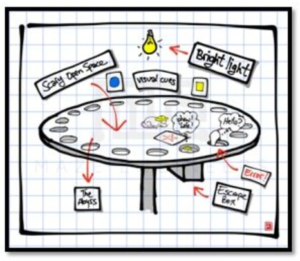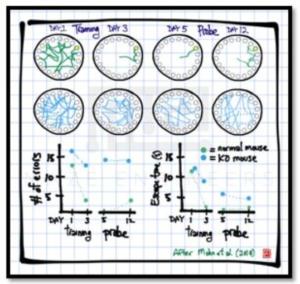Phew, you can stop holding your breath. The Barnes Maze is here! This maze is used to test similar aspects of learning and memory as the Morris water maze, but with reduced stress.
What does it look like?
The Barnes maze takes advantage of the natural desire of rodents to avoid open, exposed spaces. It consists of a large circular space with about 20 holes lining the perimeter. One of the holes has a box underneath it that mice can use to escape the maze, while the others lead to an endless abyss (ok, maybe not endless, but it’s a pretty long drop). Visual cues may surround the maze to make learning easier. Mice are placed in the middle of the maze, and the search begins (Fig. 1).

| Figure 1. Schematic of the Barnes maze. A bright light shines on a large circular platform lined with holesaround the perimeter. Only one hole leads to safety (the escape box), while others lead to an uncertain fate (no rabbits down these holes). Three mice are depicted: one at the starting location, one who has made an error and is faced with the abyss, and one who has made it to safety. Two external visual cues (circle and square) and one internal cue (star) can be used to aid the mice in navigating the maze. Overhead video camera is not depicted. |
What is measured?
Escape time, distance traveled, the number of times they check out non-escape holes (errors), and search strategy(random, sequential, or patterned).
What does normal behavior look like?
Mice performing 1-2 trials per day can learn the location of the escape hole in 2-3 days. As with the Morris water maze, escape time, distance traveled, and errors gradually reduce with learning (Fig. 2, green). Additionally, search strategies become less random/serial and more directed. After learning, cognitive flexibility can be tested by moving the escape box to a new location and assessing how soon the mice change their strategies.
What does impaired learning look like and how can the Barnes maze be used in research?
Impaired learning can take different forms depending on the nature of the underlying deficit. For example, let’s take a look at a recent paper (Mohn et al., 2014). Without getting too deep into this involved study, I’ll lay down the basics.
- Autism Spectrum Disorders and learning disabilities have been linked to mutations that delete a particular gene (adenomatous polyposis coli, for those of you who are interested).
- The authors created a knockout mouse for this gene
- They tested learning and memory in these mice using the Barnes maze test
- They also did a lot of other stuff I’m not talking about here, such as measuring levels of long-term potentiation in the hippocampus and synaptic spine densities in the cortex and hippocampus.
So, learning the location of the escape hole itself was delayed in these mice (it took about twice as long for them to learn as control mice), and when tested on probe trials after training their escape latencies and numbers of errors basically reverted to pre-training levels (Figure 2, comparison between green and blue).
Even with this brief (and possibly oversimplified) account, I think you can see how by combining Barnes maze test with physiological measurements of neural activity and the expression of specific genes, researchers can increase our knowledge of how learning and memory are regulated by our brains.

| Figure 2. Barnes Maze Test: Comparison between normal learning (green) and impaired learning (blue). Note that knockout (KO) mice lacking expression of a specific gene show delayed learning and cannot maintain the learned behavior on the probe trials. |
References/Further reading
Mohn JL, Alexander J, Pirone A, Palka CD, Lee SY, Mebane L, Haydon PG, Jacob MH. Adenomatous polyposis coli protein deletion leads to cognitive and autism-like disabilities. Mol Psychiatry. 2014 Jun 17. doi: 10.1038/mp.2014.61. [Epub ahead of print]
